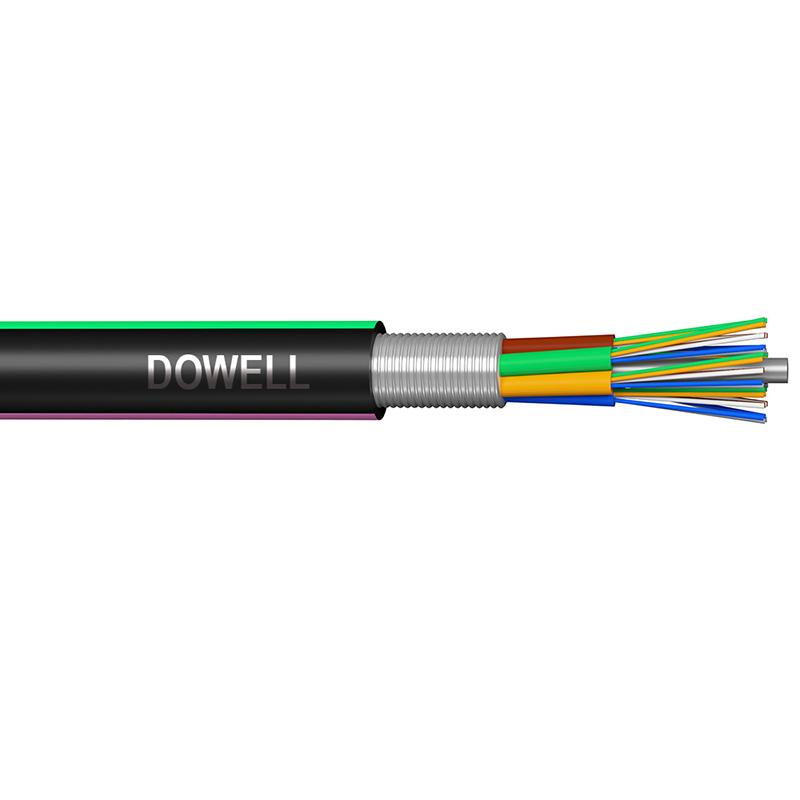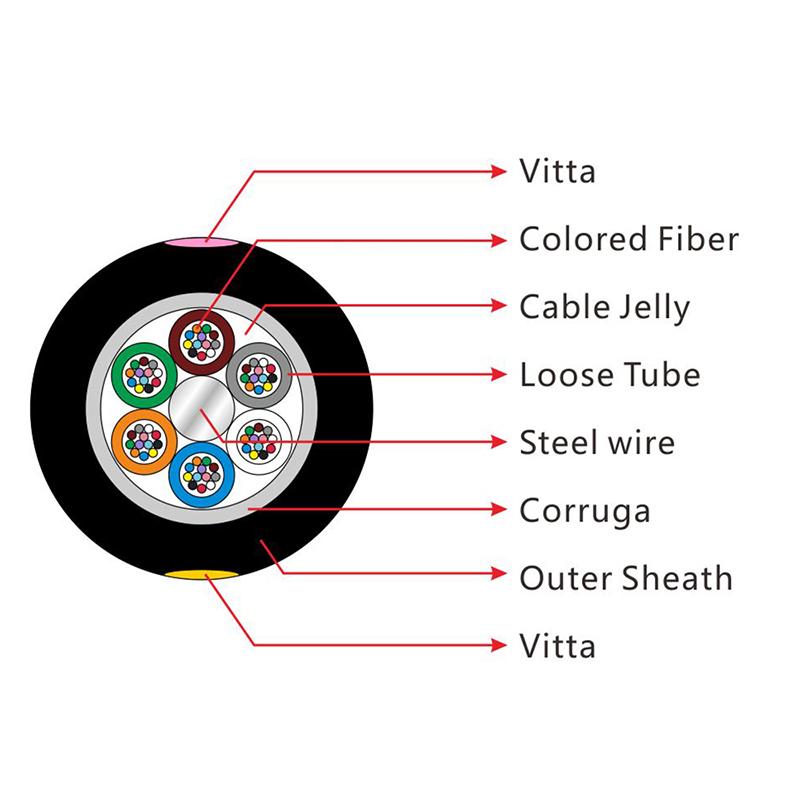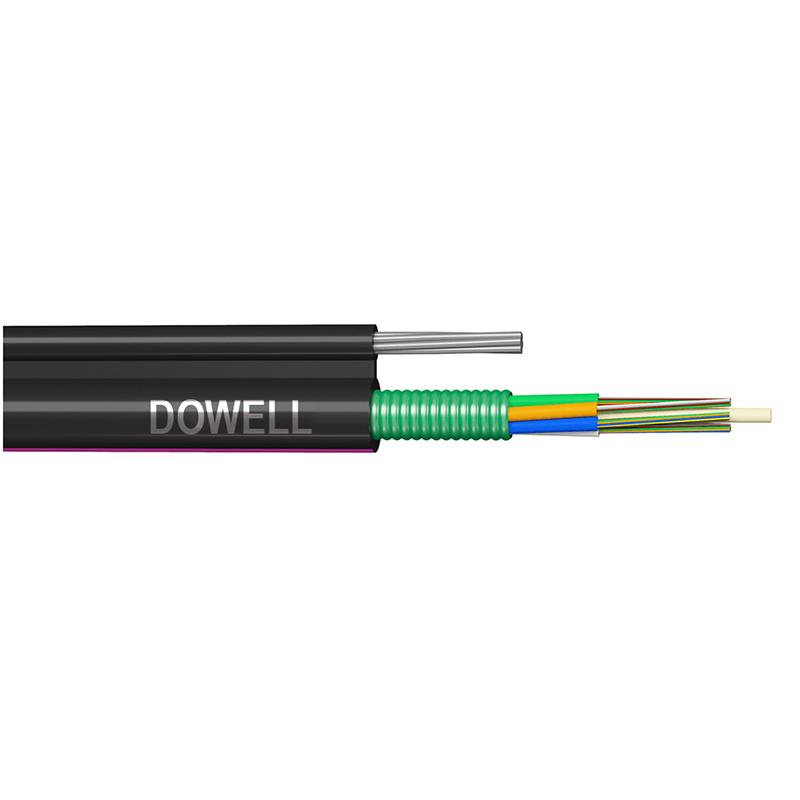
Stranded Loose Tube Non-armored Cable supports high-speed data transfer in busy data centers. This cable’s strong structure helps keep systems running smoothly. Operators see fewer interruptions and lower repair costs. Improved scalability and protection make this cable a smart choice for today’s growing digital needs.
Key Takeaways
- Stranded loose tube non-armored cable offers strong protection and reliable data transmission by using gel-filled tubes and a tough outer jacket that resist moisture, temperature changes, and physical damage.
- The cable’s flexible design and color-coded fibers make installation and repairs easier, helping data centers save time, reduce errors, and support future growth with high fiber counts.
- This cable works well in indoor and protected outdoor environments, providing lasting durability and stable performance that keeps data centers running smoothly with less downtime.
Stranded Loose Tube Non-armored Cable Structure and Features

Cable Construction for Data Center Needs
Stranded Loose Tube Non-armored Cable uses a smart design to meet the needs of busy data centers. The cable holds many coated fibers inside color-coded plastic tubes. These tubes have a special gel that blocks moisture and keeps the fibers safe. The tubes wrap around a strong center member, which can be made of steel or a special plastic. This center member gives the cable strength and helps it resist bending or pulling.
The cable also includes aramid yarn, which adds extra strength. A ripcord sits under the outer jacket, making it easy to remove the jacket during installation. The outside of the cable has a tough polyethylene jacket. This jacket protects the cable from water, sunlight, and scratches. The design keeps the fibers safe from bumps, heat, and cold, which is important for data centers.
Note: The loose tube design helps the fibers stay safe from stress and temperature changes. This makes the cable last longer and work better in data centers.
Key Features Supporting Data Center Performance
The cable offers many features that help data centers run smoothly:
- The loose tube design protects fibers from bending, moisture, and temperature swings.
- The cable can be made with different numbers of fibers to fit many needs.
- The design makes it easy to splice and connect the fibers.
- The cable resists crushing and stays strong during installation.
- The outer jacket blocks water and UV rays, so the cable works well indoors and in protected outdoor spaces.
- The cable stays light and flexible, making it easy to handle.
| Specification Aspect | Details |
|---|---|
| Tensile Rating | Minimum 2670 N (600 lbf) for standard installation |
| Minimum Bend Diameter | Defined by industry standards for safe handling |
| Color Coding | Full color coding for easy fiber identification |
| Compliance | Meets strict performance and environmental standards for data centers |
These features help the cable deliver fast, reliable data transmission and support the high demands of modern data centers.
Enhanced Data Transmission Reliability with Stranded Loose Tube Non-armored Cable
Stable Performance in High-Density Data Centers
Data centers often hold thousands of connections in a small space. Each connection must work without fail. Stranded loose tube non-armored cable helps keep data flowing smoothly, even when many cables run side by side. This cable supports high fiber counts, which means it can handle more data at once. The design uses buffer tubes filled with gel to protect each fiber from water and stress.
Many data centers face changes in temperature and humidity. The cable resists moisture, fungus, and UV rays. It keeps working well from -40 ºC to +70 ºC. This wide range helps the cable stay reliable in different environments. The cable also meets strict industry standards. These standards show that the cable can handle tough conditions and still deliver strong performance.
Tip: The stranded construction allows easy access to fibers during installation or repair. This feature saves time and reduces the risk of mistakes in busy data centers.
Some key reasons for stable performance include:
- High fiber count supports dense network setups.
- Water-blocked and moisture-resistant design protects against environmental threats.
- UV and fungus resistance keeps the cable strong over time.
- Compliance with industry standards ensures quality and reliability.
- The cable works with high-speed data protocols like Gigabit Ethernet and Fibre Channel.
Minimizing Signal Loss and Interference
Signal loss and interference can slow down or disrupt data flow. Stranded loose tube non-armored cable uses a special design to keep signals clear and strong. The loose tube structure protects fibers from bending and temperature changes. This reduces micro-bending losses and keeps the signal quality high.
The cable uses non-metallic materials, which means it does not conduct electricity. This design removes the risk of electrical interference from nearby equipment. It also protects the cable from lightning and other electrical hazards. The gel inside the tubes blocks water and keeps the fibers safe from damage.
Here is a table showing how the cable reduces signal loss and interference:
| Feature/Aspect | Description |
|---|---|
| All Dielectric Construction | Non-metallic materials remove electrical interference and keep the cable safe near high voltage. |
| Stranded Loose Tube Design | Protects fibers from stress and temperature swings, reducing signal loss. |
| Signal Performance | Low attenuation and high bandwidth support fast, reliable data transmission. |
| Mechanical Strength | Strong materials provide durability without heavy armor. |
| Interference Immunity | Non-conductive design removes EMI and lightning risks. |
| Applications | Used in places where interference reduction is critical, such as power utilities and railways. |
Loose tube cables also make repairs easier. Technicians can reach individual fibers without removing the whole cable. This feature helps keep the network running with less downtime.
Note: Fiber optic cables like these do not suffer from electromagnetic interference. This makes them ideal for data centers with lots of electrical equipment.
Simplified Installation and Scalability Using Stranded Loose Tube Non-armored Cable

Flexible Routing in Complex Data Center Spaces
Data centers often have crowded racks and tight pathways. Stranded Loose Tube Non-armored Cable helps technicians route cables through these spaces with ease. The cable’s flexible design allows it to bend and move around obstacles without breaking. Technicians can handle the cable safely, reducing the risk of fiber damage during installation. The cable resists moisture, temperature changes, and UV radiation, so it works well in many environments.
- Flexibility makes routing easier in tight spaces.
- The cable protects against moisture and temperature swings.
- High fiber count supports large data loads.
- Technicians can repair individual fibers without replacing the whole cable.
- The cable stands up to harsh conditions and physical stress.
- Durable construction means fewer replacements and lower costs.
Tip: Technicians can access and repair fibers quickly, which keeps the network running smoothly.
Supporting Easy Expansion and Upgrades
Data centers must grow and change to meet new demands. Stranded Loose Tube Non-armored Cable supports this need for expansion. Modular patch panels allow easy upgrades and reconfigurations. Spare cable trays and pathways help add new infrastructure without crowding. Slack loops give room for movement and changes, preventing congestion. Flexible cable layouts make it simple to support new technologies.
A table shows how the cable supports scalability:
| Scalability Feature | Benefit |
|---|---|
| Modular Patch Panels | Quick upgrades and changes |
| Spare Pathways | Easy addition of new cables |
| Slack Loops | Smooth movement and adjustments |
| Flexible Layouts | Support for future technologies |
The cable’s flexible construction helps data centers adapt quickly. Technicians can install new cables or upgrade systems without major disruptions.
Superior Protection Against Environmental Factors
Moisture and Temperature Resistance
Data centers face many environmental threats that can damage cables. Moisture and temperature changes are two of the most common risks. Loose tube cables use buffer tubes filled with a special gel. This gel blocks water from reaching the fibers inside. The cable jacket also resists UV rays, which helps protect it from sunlight.
Manufacturers test these cables in many ways to make sure they can handle tough conditions. Some of the main tests include:
- UV weather testing to check how the cable stands up to sunlight and moisture.
- Water resistance testing to see if water can get inside the cable.
- Pressure testing at high temperatures to measure how the cable performs when it gets hot.
- Cold impact and cold bending testing to make sure the cable stays strong and flexible in the cold.
These tests show that the cable can keep working even when the environment changes quickly. The loose tube design lets the fibers move a little inside the tube. This movement helps prevent damage when the temperature goes up or down.
| Environmental Threats / Factors | Loose Tube Non-Armored Cable Features | Explanation |
|---|---|---|
| Moisture | Fibers isolated in buffer tubes with moisture resistance | Loose tube design protects fibers from moisture ingress, suitable for outdoor and harsh environments |
| UV Radiation | Designed for outdoor use with UV resistance | Loose tube cables withstand UV exposure unlike indoor cables |
| Temperature Fluctuations | Flexibility to accommodate thermal expansion/contraction | Buffer tubes allow fiber movement, preventing damage from temperature changes |
Note: These features help keep data flowing smoothly, even when the weather changes.
Durability for Indoor and Protected Outdoor Use
Loose tube non-armored cables work well in both indoor and protected outdoor spaces. The cable uses a strong polyethylene jacket that shields it from scratches and sunlight. While it does not have a metal armor layer, it still offers good protection in places where heavy impacts are not likely.
Compared to armored cables, non-armored types are lighter and easier to install. They cost less and fit well in areas where rodents or heavy machinery are not a problem. The cable’s design makes it a smart choice for data centers that need reliable connections without extra weight.
- Suitable for indoor and protected outdoor environments
- Lightweight and flexible for easy routing
- Offers fire and smoke protection with LSZH jackets
| Aspect | Armored Stranded Loose Tube Cable | Non-Armored Stranded Loose Tube Cable |
|---|---|---|
| Protective Layer | Has an additional armor layer (metal or fiber-based) | No armor layer |
| Mechanical Protection | Enhanced protection against rodent damage, moisture, physical impact | Limited mechanical protection |
| Water Resistance | Armor and sheath protect against moisture ingress | Uses water-blocking compounds and polyethylene sheath for waterproofing |
| Suitable Environments | Harsh, unprotected outdoor, direct burial, exposed runs | Indoor and protected outdoor environments |
| Durability | More durable in demanding conditions | Sufficient durability indoors and in protected outdoor use |
| Cost | Generally more expensive due to armor | Less expensive |
Tip: Choose non-armored cables for areas where the risk of physical damage is low, but environmental protection is still important.
Reduced Maintenance and Downtime with Stranded Loose Tube Non-armored Cable
Lower Risk of Physical Damage
Data centers need cables that can stand up to daily use. Stranded loose tube non-armored cable offers strong protection for the fibers inside. The cable uses a tough outer jacket that shields the fibers from bumps and scrapes. Workers move equipment and walk through aisles every day. The cable resists crushing and bending, so it stays safe even in busy areas.
The design keeps the fibers away from sharp impacts. The loose tubes inside the cable allow the fibers to move slightly. This movement helps prevent breaks when someone pulls or twists the cable. The water-blocking gel inside the tubes adds another layer of safety. It keeps moisture out and stops damage from spills or leaks.
Tip: Choosing cables with strong jackets and flexible tubes helps data centers avoid costly repairs.
A table shows how the cable protects against common risks:
| Physical Risk | Cable Feature | Benefit |
|---|---|---|
| Crushing | Tough outer jacket | Prevents fiber damage |
| Bending | Flexible loose tube design | Reduces breakage |
| Moisture | Water-blocking gel | Stops water from reaching fibers |
| Scrapes and bumps | Polyethylene sheath | Shields cable from harm |
Streamlined Troubleshooting and Repairs
Quick repairs keep data centers running smoothly. Stranded loose tube non-armored cable makes troubleshooting easier for technicians. The color-coded tubes help workers find the right fiber fast. Each tube holds several fibers, and each fiber has its own color. This system reduces mistakes during repairs.
Technicians can open the cable and reach only the fiber that needs fixing. They do not need to remove the whole cable. The ripcord under the jacket lets workers strip the cable quickly. This feature saves time and lowers the chance of damaging other fibers.
A simple repair process means less downtime. Data centers can fix problems and get back to work faster. The cable’s design supports easy splicing and joining. Workers can add new fibers or replace old ones without trouble.
- Color coding helps identify fibers quickly.
- Ripcord allows fast jacket removal.
- Loose tube design supports easy access for repairs.
- Technicians can fix one fiber without disturbing others.
Note: Fast troubleshooting and repair features help data centers maintain high uptime and reduce costs.
Real-World Data Center Applications of Stranded Loose Tube Non-armored Cable
Case Study: Large-Scale Data Center Deployment
A major technology company needed to upgrade its data center to handle more users and faster speeds. The team chose a fiber optic cable with a loose tube design for the new network backbone. Workers installed the cable in long runs between server rooms and network switches. The flexible structure allowed easy routing through crowded cable trays and tight corners.
During installation, technicians used the color-coded fibers to organize connections. This system helped them finish the job quickly and reduced mistakes. The water-blocking gel inside the tubes protected the fibers from humidity in the building. After the upgrade, the data center saw fewer outages and faster data transfers. The cable’s strong jacket protected it from bumps and scrapes during daily operations.
Note: The team reported that repairs became easier. Technicians could access and fix single fibers without disturbing the rest of the network.
Insights from Industry Implementations
Many data centers use this type of cable for both new builds and upgrades. Operators value the cable’s flexibility and strength. They often highlight these benefits:
- Easy installation in complex spaces
- Reliable performance in changing temperatures
- Simple repairs with color-coded fibers
- Long service life with minimal maintenance
A table below shows common reasons data centers select this cable:
| Benefit | Description |
|---|---|
| Flexibility | Fits tight spaces and bends easily |
| Moisture Protection | Keeps fibers dry and safe |
| Fast Repairs | Quick access to individual fibers |
| High Capacity | Supports many connections |
Stranded Loose Tube Non-armored Cable gives data centers strong performance, easy installation, and lasting protection. Key benefits include:
- Gel-filled tubes and strong jackets improve safety and durability.
- Flexible design supports future growth and new technology.
- Use this table to check if the cable fits your needs:
| Criterion | Details |
|---|---|
| Temperature Range | -40 ºC to +70 ºC |
| Fiber Count | Up to 12 fibers per cable |
| Application | Indoor/Outdoor, LAN, backbone |
FAQ
What environments suit stranded loose tube non-armored cable best?
Data centers, indoor spaces, and protected outdoor areas use this cable. It works well where moisture and temperature changes may occur.
How does this cable help reduce downtime?
Color-coded fibers and a ripcord allow fast repairs. Technicians can access and fix single fibers without disturbing the rest.
Can this cable support future data center growth?
Yes. The cable’s flexible design and high fiber count make it easy to add new connections and upgrade systems as needs change.
Post time: Aug-15-2025
